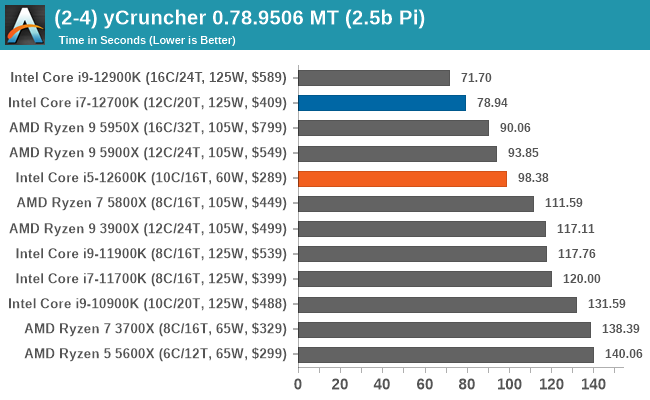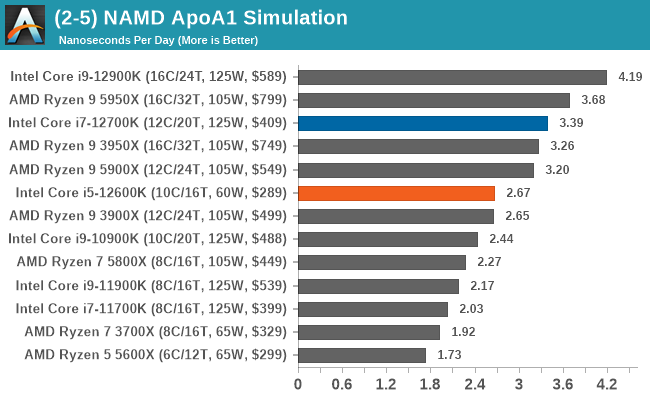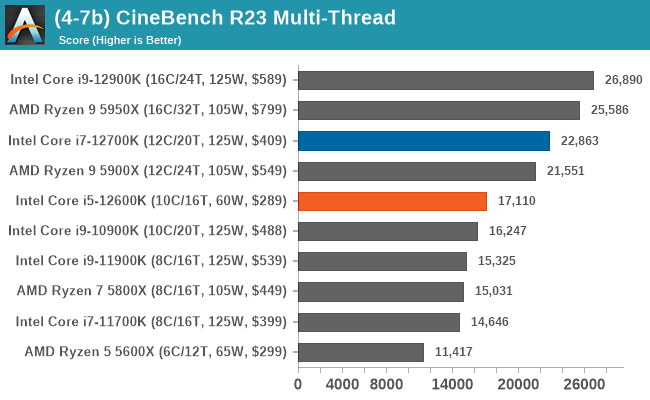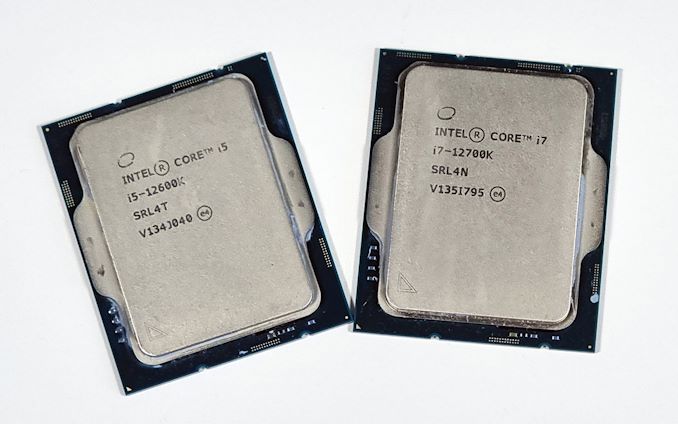The Intel Core i7-12700K and Core i5-12600K Review: High Performance For the Mid-Range
by Gavin Bonshor on March 29, 2022 8:00 AM ESTConclusion
As we make good headway into 2022 and beyond, the dynamic of the CPU market is constantly changing and evolving. What was once for many years a war based on core count on chips between Intel and AMD has now become a battle of whose core performs more efficiently, is faster, and offers better value. It's no surprise that both of Intel and AMD's flagship offerings (Core i9-12900K versus Ryzen 9 5950X) have been one based on everything but value; both companies have respectively changed the desktop processor market for the better.
In what is possibly our final look at Intel's 12th Gen Core series processors, I feel that it has been a successful launch for one main reason. This all comes down to value, as 12th Gen Alder Lake has been one of the first Core series since AMD launched its Zen architecture back in 2017 to offer users something that feels like good value for the price, compared to what it has done in the past. Not only that, but Intel has bridged the gap between themselves and AMD with improved IPC performance, which leapfrogs AMD's Zen 3 architecture. Another element is in multi-threaded applications. The increased IPC with the Golden Cove P-Cores combined with its Gracemont E-Cores helps negate some of AMD's Ryzen 5000 series previous dominance in certain situations where higher core counts are favored.
The 12-Core to 8-Core Desktop Processor Market: Alder Lake Makes a Splash
While it has been noted by several outlets and retailers over the last month, AMD has finally cut the pricing on its Ryzen 5000 series desktop processors. This doesn't just feel like a ploy from AMD to increase competitiveness against Intel's 12th Gen Core offerings. Still, it's notable that it's taken AMD this long to catch up with demand for their chips. It underscores how everything below high-end/flagship CPUs has been rather underserved for the last year and a half, as chip shortages have sent resources elsewhere.
Turning back to now, and as it stands, Intel's Alder Lake offers more in terms of performance for the price, especially in the sub $450 processor market.
| Intel Versus AMD Mid-Range Price Comparison (as of 03/20) | ||||||
| Intel Core 12th Gen |
Cores | Price ($) |
Price ($) |
Cores | AMD Ryzen 5000 |
|
| Core i7-12700K | 8+4 (12) | $385 | vs. | $485 | 12C | Ryzen 9 5900X |
| Core i5-12600K | 6+4 (10) | $279 | vs. | $390 | 8C | Ryzen 7 5800X |
As well as AMD's recent price drops on its Ryzen 5000 offerings, we've been noticing small and subtle price drops on Intel's 12th Gen Core series too. This means that despite the Ryzen 9 5900X, which is currently on sale for $485 at Amazon, is undoubtedly a better price than it was ($570), the Intel Core i7-12700K is now available at the lower cost of $385 at Amazon. Intel's offering better value and is around 20% cheaper when comparing both chips at Amazon; other retailers may vary.
Looking at the differentials in the other battle between the Core i5-12600K and Ryzen 7 5800X, the same can also be applied. The Ryzen 7 5800X, which now costs $390 at Amazon, is down from $450. In contrast, the Core i5-12600K is available for $280 at Amazon, which means Intel is around 20% cheaper on its 10-core 12th Gen series chip.
It's worth noting that due to AMD's Zen 3 chiplet design, its Core Chiplet Die (CCD) is limited to 1 x CCD of 6-cores and 8-cores at the moment, meaning an actual 10-core competitor to the Core i5-12600K isn't viable, at least from a cost and yield standpoint. AMD could release a 10-core Ryzen 5000 processor if it disabled cores on one of the CCDs, but this again wouldn't be viable from AMD's perspective.
Intel is currently winning the pricing war when it comes to the value proposition in both the respective markets (12C and 10/8C). This can and would only change if AMD decided to cut its pricing even further, though at this point the deciding factor doesn't seem to be Alder Lake's performance, but rather how much of AMD's 7nm wafer allocation is being consumed by higher margin products like EPYC chips. Make no mistake, Intel's mid-range and enthusiast class Alder Lake chips are legitimately good, but there's also an element of "winner by default" at play due to AMD's seemingly limited chip volumes in these segments.
Core i7-12700K and Core i5-12600K Performance Analysis:
Focusing on the performance of both the Core i7-12700K and Core i5-12600K, both processors are competitive and have viable trade-offs against the competition. For the purposes of acknowledgment, we've included both the Core i9-12900K and Ryzen 9 5950X into our data arc for this review. This allows us to better judge the propositions of value and competition throughout Intel's Alder Lake offerings and AMD's Ryzen 5000 desktop chips.

Taking a look at some benchmarks that reasonably conclude the landscape of the desktop market, our science-based yCruncher benchmark shows the natural levels of performance when comparing Alder Lake to Zen 3. In this test, the Alder Lake-based 12th Gen Core processors outperform each of their market rivals. The Core i5-12600K sits between both the Ryzen 9 5900X and the Ryzen 7 5800X here, which is relative to the core count and the difference in IPC performance between both architectures.

In another science-focused benchmark, both the Core i7-12700K and Core i5-12600K perform well in respect to the competition. The NAMD ApoA1 simulation benchmark favors a mixture of core/thread count, with faster cores at equal core counts proving more effective.

The popular Cinebench R23 benchmark is used often by manufacturers and media alike to show off rendering performance across the single and multi-threaded performance. We already know that Alder Lake has an IPC advantage over Zen 3, as seen in our previous Core i9-12900K and Core i3-12300 reviews, so we're focusing on multi-threaded performance here.
Both the Core i7-12700K and Core i5-12600K perform well in the Cinebench R23 Multi-Thread test, and while it's notable that the flagship Core i9-12900K reigns supreme, the Core i7-12700K isn't too far behind the Ryzen 9 5950X, which is exceptional.
While it is fair to say that the use of DDR5 memory on Alder Lake is definitely a contributing factor to some of the extra performance gains, it's fair to judge performance based on the achievable performance using the best technologies available. Overall, the Core i7-12700K is perhaps the best sub $400 processor from a price to performance point of view, and this is confirmed throughout our testing. In contrast, using Windows 11 over Windows 10 yields little gain, and we also test with memory settings based on what the chip is capable of based on JEDEC settings.

The recent offerings from both Intel and AMD perform well in gaming, with much of the variation in performance surrounding what each of the game developer's titles is aligned with. This means that game titles that partner with Intel generally performs better due to code and integrated technologies. At the same time, AMD has the same thing with the developers it partners with. The overall situation in gaming performance is quite simple; all of the 8C+ processors from both team Intel (Alder Lake) and team AMD (Zen 3) all perform well, with slight nuances based on the game developer's level of its multi-threaded application being another contributing factor to performance.
Summary
Selecting a processor to build a new system or upgrade an existing one, both Intel and AMD have plenty of options for users to sink their teeth into. There's something for everyone when it comes to selecting the best processor for the task at hand, be that rendering, a workstation, a gaming system, or even just for web-browsing.
Getting straight to the point on our opinion of Intel's 12th Gen Core i7-12700K and Core i5-12600K processors, both perform very well and are the best all-round performers at their respective price points. When it comes to selecting a processor between $250 and $450 for a gaming system, it makes very little sense than to opt for the Core i5-12600K, as it has a good balance of cores (10C/16T) with enough performance on those cores to make it a no brainer for $279.

The Intel Core i5-12600K (left) and Core i7-12700K (right) processors.
The extra money saved opting for the Core i5-12600K over the Core i7-12700K could be put towards a better video card, which would offer a more significant jump in frame rates over opting for the more expensive processor. It's clear that the Core i7-12700K and Core i5-12600K are a better buy, both from a value and performance perspective over the competing AMD Ryzen 5000 series processors.
Overall, Intel's Alder Lake architecture is an important win for the company that has consistently lost desktop processor market share since Zen debuted back in 2017. Even with the launch of AMD's Ryzen 7 5800X3D, due on April 20th, it's more likely to be competitive with the Core i7-12700K in gaming, and if its 96 MB of 3D V-Cache is as effective in gaming as AMD suggests, it could be neck and neck there. However, the Core i7-12700K benefits from an unlocked multiplier, and system tweakers are more likely to get a better price to performance ratio with Intel.
Right now, Alder Lake has the competitive advantage over Zen 3, and that's to be expected, as this is the second attempt from Intel to close the gap between itself and AMD's Ryzen 5000 lineup. The biggest question is, what's on the horizon? We know AMD is planning to release its Zen 4 5 nm based processors sometime this year, and the generational gap between Zen 2 and Zen 3 was very impressive. It still remains to be seen how that pans out, but for now, Intel's 12th Gen Core series is certainly worthy of consideration, especially with its more aggressive pricing.










196 Comments
View All Comments
mode_13h - Sunday, April 3, 2022 - link
> looking at my own decompiled codeThis is a bad way to judge performance. You should use profiling tools like VTune to know how much runtime is spent in the FP-heavy code, because that's what counts.
> I'd be highly surprised if the integer side isn't the critical path most of the time.
I'm sure it depends a lot on the type of game and the game engine being used.
Dolda2000 - Sunday, April 3, 2022 - link
Well, certainly, running objdump was just easier in order to type up a comment, but looking at a Linux perf recording of a typical run certainly also doesn't reveal a single FP-heavy function at the top of the heatmap.mode_13h - Monday, April 4, 2022 - link
> looking at a Linux perf recording of a typical runYou mean operf?
When profiling optimized code with any tool, you obviously want to keep in mind that inlining can cause some functions either to vanish or seem to have a lot less footprint than they actually do.
Spunjji - Friday, April 1, 2022 - link
"Thuban was a better design, so updating the instruction set would have made a better product than bulldozer."False. Thuban hit a hard clock limit and it was never very competitive with Core.
If you're going to blame AMD for Intel's abuse of their dominant position because AMD didn't compete, you kinda have to blame Intel for staving AMD of cash when they had better designs, leading to the abd decisions that resulted in Bulldozer...
Qasar - Friday, April 1, 2022 - link
i have seen comments from some that if intel didnt stagnate the market, and stick the mainstream with 4 cores, for all those years before zen was released, it would of put amd out of business.eek2121 - Saturday, April 2, 2022 - link
You have 'seen' correctly. If Intel had kept innovating, AMD would not exist right now. They didn't, so AMD not only exists, but is stealing their breakfast and lunch money. Intel can only keep losing until they address the biggest elephant in the room: efficiency. Using 241W to beat a CPU that consumes half the power isn't efficient.Qasar - Saturday, April 2, 2022 - link
eek2121, sure we " could " say that now, but in the end, NO one knows 100% for sure. i have seen some very heated debates on this as well. one person even said, intel did this, just so it wouldnt put amd out of business. yea right, since when has intel ever done anything for the benefit of others.Khanan - Thursday, April 7, 2022 - link
Eh nonsense. AMD kept itself alive by pushing console APUs and even if Intel would’ve stayed ahead they could’ve made money with CPUs on desktop anyway.mode_13h - Saturday, April 2, 2022 - link
> if intel didnt stagnate the market, and stick the mainstream with 4 cores,> for all those years before zen was released, it would of put amd out of business.
I really wanted the FTC to break up Intel, forcing it to spin out its fabs. The FTC has done things like this, in the past, but not recently. Judging by how competitive the CPU market became when TSMC caught up with Intel, I think the whole industry would've benefited.
Mike Bruzzone - Tuesday, April 5, 2022 - link
@mode_13thIf Intel were to spin out or off fabs they're different approaches, the fabs (as some financial analysts illogically proposed as financial analysis, more like shills for some institutional investment think seller houses like vultures) Intel would collapse under the weight of its own cost structure built around those fabs, a 30 year monopoly cost structure is difficult to fuel when chopped off from its multiple heads think Hydra. Removing the kilns from design production would devastate the design and manufacturing side simultaneously in relation to the on waiting competitors. The cause is Intel structural elephantiasis, having to sustain the costs of historically a monopoly structure before fully cost optimizing, pulling out the unnecessary costs, tied to that x2 to x3 processor production volume over annual computer 'real time demanded volume' to pay for Moore's Law. AND now 2.5 full node cycles across so said 5 nodes (its really 2.5) in 4 years its going to be interesting to watch from an enterprise cost : price / margin perspective.
Spinning out the fabs would be too great for Intel as an enterprise, less fabrication, and the Intel house of cards, the current structure on its maintenance cost weight, would collapse. The place would really have to be gutted, the variable cost of operations meaning people especially on the operations management side would have to be well cost back.
I'm for IFS and for Intel foundry on every attempt. Attempting to cost optimize overall enterprise structure reconfiguring for 'real time demand. Producing for real time demand verse producing for x2 to x3 MPU supply over computer demand meant by Intel to pay for Rocks CapEx doubling law while simultaneously holding channels financially tied up with Intel processor surplus production 'weight'.
Spinning out presumes sale. Spinning off does not necessarily presume sale of the fabs. One spin off option it to federate the various fabs, placing each on its own balance sheet and enabling more autonomy over what type of products each decides to produce which of course is what they're good at technically, economically and in terms of profitably. Under this federated model, none would walk away from Intel Conglomerate (think ARM Holdings) model on existing processor volume none would walk away from that volume at least for the near term.
Under a federated model and decision making is already that way currently, more or less, every fab now operates on it own balance sheet opening to up every manufacturing division, and where Intel already has design divisions, to its own R&D and innovation and the capital markets. Where every fab operates under a federated model but still combines financially with the parent entity, Intel Conglomerate, think ITT, to chose what customer, Intel or others the fab works, what the fab will produce which again is what they're good at technically, economically and financially.
This federated 'conglomerate' model makes greater sense as IFS itself under the current whole enterprise structure becomes successful. It's an option as the dynamics of monolithic processor volumes morph into systems in package.
mb